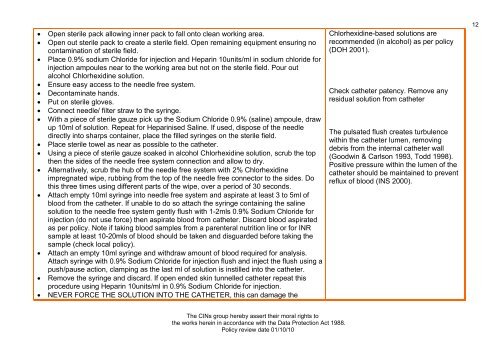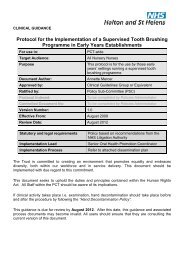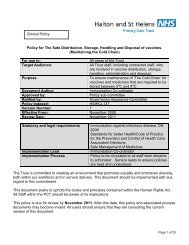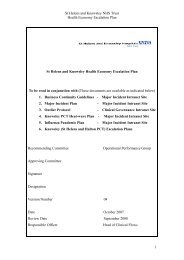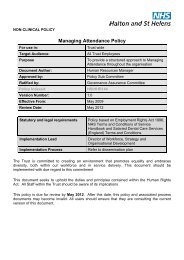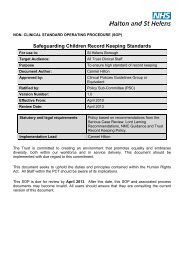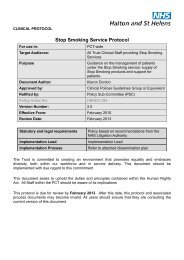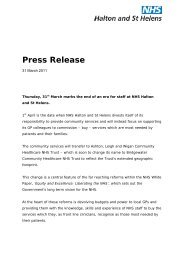Collaborative Intravenous Nursing Service (CINS) Guidelines
Collaborative Intravenous Nursing Service (CINS) Guidelines
Collaborative Intravenous Nursing Service (CINS) Guidelines
- No tags were found...
Create successful ePaper yourself
Turn your PDF publications into a flip-book with our unique Google optimized e-Paper software.
• Open sterile pack allowing inner pack to fall onto clean working area.• Open out sterile pack to create a sterile field. Open remaining equipment ensuring nocontamination of sterile field.• Place 0.9% sodium Chloride for injection and Heparin 10units/ml in sodium chloride forinjection ampoules near to the working area but not on the sterile field. Pour outalcohol Chlorhexidine solution.• Ensure easy access to the needle free system.• Decontaminate hands.• Put on sterile gloves.• Connect needle/ filter straw to the syringe.• With a piece of sterile gauze pick up the Sodium Chloride 0.9% (saline) ampoule, drawup 10ml of solution. Repeat for Heparinised Saline. If used, dispose of the needledirectly into sharps container, place the filled syringes on the sterile field.• Place sterile towel as near as possible to the catheter.• Using a piece of sterile gauze soaked in alcohol Chlorhexidine solution, scrub the topthen the sides of the needle free system connection and allow to dry.• Alternatively, scrub the hub of the needle free system with 2% Chlorhexidineimpregnated wipe, rubbing from the top of the needle free connector to the sides. Dothis three times using different parts of the wipe, over a period of 30 seconds.• Attach empty 10ml syringe into needle free system and aspirate at least 3 to 5ml ofblood from the catheter. If unable to do so attach the syringe containing the salinesolution to the needle free system gently flush with 1-2mls 0.9% Sodium Chloride forinjection (do not use force) then aspirate blood from catheter. Discard blood aspiratedas per policy. Note if taking blood samples from a parenteral nutrition line or for INRsample at least 10-20mls of blood should be taken and disguarded before taking thesample (check local policy).• Attach an empty 10ml syringe and withdraw amount of blood required for analysis.Attach syringe with 0.9% Sodium Chloride for injection flush and inject the flush using apush/pause action, clamping as the last ml of solution is instilled into the catheter.• Remove the syringe and discard. If open ended skin tunnelled catheter repeat thisprocedure using Heparin 10units/ml in 0.9% Sodium Chloride for injection.• NEVER FORCE THE SOLUTION INTO THE CATHETER, this can damage theChlorhexidine-based solutions arerecommended (in alcohol) as per policy(DOH 2001).Check catheter patency. Remove anyresidual solution from catheterThe pulsated flush creates turbulencewithin the catheter lumen, removingdebris from the internal catheter wall(Goodwin & Carlson 1993, Todd 1998).Positive pressure within the lumen of thecatheter should be maintained to preventreflux of blood (INS 2000).12The CINs group hereby assert their moral rights tothe works herein in accordance with the Data Protection Act 1988.Policy review date 01/10/10


